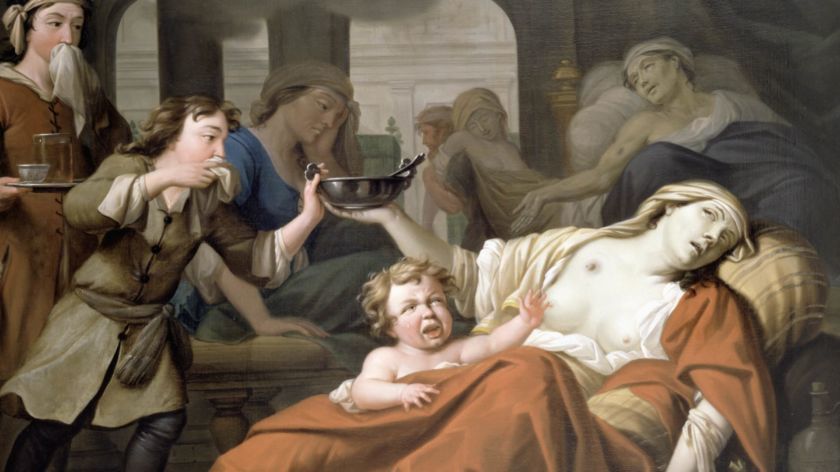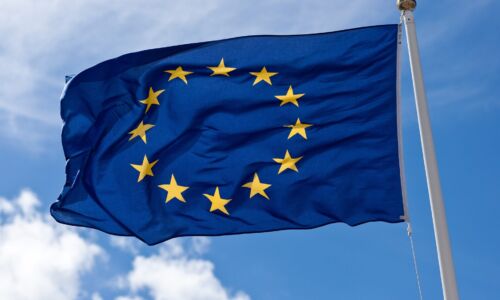Parallels with the plague
-
 Theodoor van der Schuer, Pestlijders in een gasthuis (Black Death victims in a hospital) (1682), Museum De Lakenhal.
Theodoor van der Schuer, Pestlijders in een gasthuis (Black Death victims in a hospital) (1682), Museum De Lakenhal.
Johan Oosterman has been working on an exhibition about the Black Plague for a while now. The Professor of Medieval and Early Modern Dutch Literature could not have imagined how topical his project would become.
A year ago, the Valkhof Museum acquired a fine wooden statue of Saint Sebastian, the Patron Saint of plague victims. This inspired the idea to organise an exhibition on the Black Death, the disease that decimated the medieval population between 1347 and 1351, and later led to a number of severe local outbreaks, for example in 1635-1636 in Nijmegen.
Johan Oosterman knew about the horrors of large-scale historical pandemics from medieval eyewitness accounts and family stories. ‘My grand-father had the Spanish flu. He nearly died, but then he recovered.’ However, these are all stories from the past. In January, Oosterman was still explaining to an acquaintance the impact of the Black Death, how it had killed from one third to half of Europe’s population in just three Johan Oosterman has been working on an exhibition about the Black Plague for a while now. The Professor of Medieval and Early Modern Dutch Literature could not have imagined how topical his project would become. Parallels with the plague months’ time. ‘Imagine what would happen if we had an outbreak now,’ I mused. ‘It would mean the death of 65,000 of the 170,000 Nijmegen residents. It would completely destabilise the economy and society.’

A few weeks later Covid-19 appeared on the scene. ‘This kind of pandemic used to be a fascinating historical phenomenon, now it dominates the daily news. Much of what happened then is happening again, from utter uncertainty to bizarre theories and scapegoating. It really makes you think: there’s lots of stereotyping in history books, but now you can really see it happening.’
Social distancing
Oosterman reads and studies sources with different eyes now, and with more recognition. For example a letter by a Canon, dated 1349. ‘He describes the steady spread of the disease to his friends in Bruges. ‘Half a year ago it first appeared in Genoa; now it has reached Avignon. It’s coming to you too, so beware!’’

What we now call social distancing and the 1.5 metre society were familiar concepts to medieval people. ‘Their measures weren’t that different from ours. The only difference is that we are working on developing a vaccine. People in the Middle Ages didn’t have that kind of future perspective.’ Black Death victims and their relatives had to be easily recognisable and carried a red stick when walking on the street. ‘Kind of like our coronavirus app.’

Then, as now, the pandemic exacerbated existing social inequality. ‘The rich fled to their homes in the mountains or, like the wealthy youths in the Decameron, they isolated themselves in a healthy environment and told each other stories.’ The Pope of Avignon took the concept of lockdown to new extremes: he locked himself up in his castle, had all the holes plugged, and lit huge fires to keep the Black Death at bay.
Scapegoats
These days it’s the 5G masts that get the blame, but in earlier times people blamed the Jews. By choice or by law, Jews lived in separate quarters, and their faith required them to adhere to strict hygiene measures, as a result of which, there were relatively fewer victims among them. This made them ideal scapegoats: people claimed they were poisoning the Christians’ water sources. To stop the Black Death, people carried out massive burnings of Jews.
‘Some chronicles, like those of the Abbot of a monastery in Doornik, describe these burnings in a neutral tone, but other authors are openly anti- Semitic.’ One example is Jan van Boendale’s Boec vander Wraken (The Book of Revenge). ‘I think he’s an amazing author, but these sections are downright unpleasant. Medieval people saw the Black Death as God’s punishment for human sins, but Van Boendale is actually saying: persecuting Jews is more effective than doing penance.’
Not only did the Black Death dominate medieval sources, it continued to appear as a motif in much later literature, and the visual arts in particular. ‘The Black Death came to symbolise the disasters that can befall humanity. It was and remains the largest pandemic ever, with hundreds of millions of victims in a world much less densely populated than today. This is something that continues to appeal to our imagination.’
Coronavirus permitting, the black death exhibition will open on October 15th 2020 at the Valkhof Museum. Not all images on these pages are included in the exhibition.



